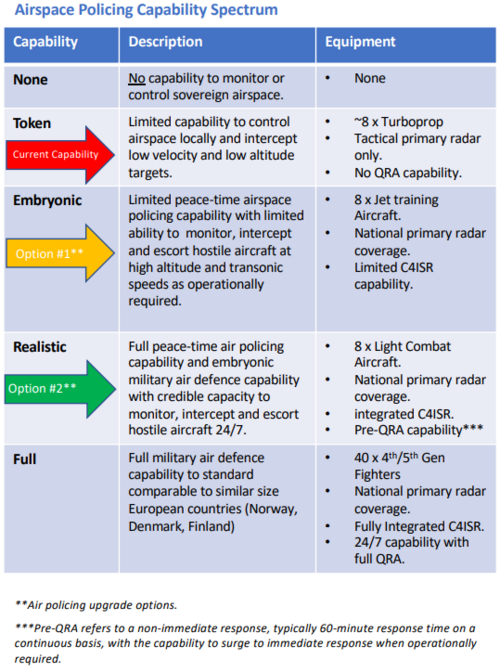- Joined
- 9 October 2009
- Messages
- 21,841
- Reaction score
- 13,373
for some reason ‘interceptors’makes me go all Gerry Anderson.....
I'm occasionally that way myself...
for some reason ‘interceptors’makes me go all Gerry Anderson.....
Of course if we were to talk about supersonic interceptors, then South Korea and the wildcard of Taiwan are possible suppliers.
I don't see China being allowed to tender.
Though a variant of the US-Swedish trainer is the strongest potential option.
Northern Ireland has no long range radar stations.... None since the cold war ended... There used to be 2 Rotor stations- one at killard point (beside what was RAF Bishopscourt- which is now a race track at which I do motorcycle track days) and one at fair head on the north coast. We have only a minimal RAF base at Aldergrove which is the main civilian airport (Belfast International)I don’t know, ships, Northern Ireland? Space?
Purely for entertainment.
Ireland's last fast jet (as used in "On Her Majestys Secret Service' as a Swiss Mirage)
And two aircraft mentioned as possible replacements
.

Well what about the Argentinian IA-63 Pampa
I could carry two 7,62 mm gun pods plus 125 kg freefall bombs

I would say the South Korean T50 Golden Eagle ought to be reasonable.Well what about the Argentinian IA-63 Pampa
I could carry two 7,62 mm gun pods plus 125 kg freefall bombs

Are you planning to bomb another plane?
The notional mission is air policing, which is a strictly air-to-air effort. That means any solution needs radar (or maybe a pretty advanced IRST) and air-to-air missiles. Arguably Ireland might actually want to actively omit air-to-ground weapons entirely.
The F-20 would have been nearly ideal, decades ago. Today, Gripen would be almost the only credible option. (C/D models with IRIS-T and Meteor only, to minimize the dependence on US suppliers?)
Why not Hawk then? Since the supplier is literally next door.
Gripen would reinforce the non-aligned status. I think Sweden has been pretty flexible in 'loaners', and would probably allow them to buy another sqn of the newer Gripen.I suppose there is the option of renting Gripen....but are there available aircraft to rent and is it worth the ongoing cost?
Good luck with that.....Gripen would reinforce the non-aligned status. I think Sweden has been pretty flexible in 'loaners', and would probably allow them to buy another sqn of the newer Gripen.I suppose there is the option of renting Gripen....but are there available aircraft to rent and is it worth the ongoing cost?
And they could operate them off the M50.......

I think they want to be seen to carry their own weight in Europe.Why would they do that when they can get someone else to do it? SImplist way of looking at it, the continued outlay would be more than they are willing to do more than think about.
The Irish do a lot of training with the UK already, but the UK MFTS is struggling as it is. Reality is (apart from the fact it will never happen...) is training would need to be provided by whichever nation sold them the jets.Where it would be is anyone's guess but I would posit an eu nation, France possibly.
The UK will cover the Republic’s back at all times, as the Republic’s back is the UK’s back.Ireland isn't part of NATO and has been historically sparsely armed despite being a neutral nation. That leaves it vulnerable to some extent and quite rightly it can't assume that the UK or EU will be willing or able to cover its back at all times.


Yes this is my feeling too, making what looks expensive seem less expensive than the super platinum-plated option.It also has the secondary advantage of making the other options such as option 2 - a significantly scaled up and better equipped defence force, twice as expensive but still with no actual fighter aircraft - appear more reasonable/ palatable to a country highly wedded to it’s neutrality.
Unless the UK splits up of course...The UK will cover the Republic’s back at all times, as the Republic’s back is the UK’s back.
Too many Spice Girls and not enough Beatles to share out for that to happen.Unless the UK splits up of course...
Lower pay with hgher housing costs and paid for healthcare....less flying, less deployments...not a hope.nd they assume pilots arrive trained (hiring ex-RAF pilots with dual UK-Irish citizenship?)
Lower pay with hgher housing costs and paid for healthcare....less flying, less deployments...not a hope.nd they assume pilots arrive trained (hiring ex-RAF pilots with dual UK-Irish citizenship?)
They'd have to compete with the ME contracts. But any such procurement would be multi-year, they might want to draft in a couple of more senior pilots to set up the system, but they'd be time to train Irish pilots up. The problem would be keeping them long term...instead of being a flight academy for Ryanair....Might find some folks who are done with their RAF careers and wouldn't mind a less strenuous gig.
Is this related to Vlad Putin naval saber rattling off their coast, recently ?

